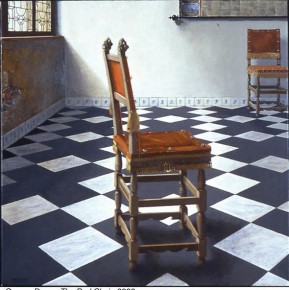Related WorksNo related works found. |
| WorkRed Chair, The
| Image Notes
Reference Vermeer The Art of Painting, c. 1666-67. Kunsthistorisches Museum, Vienna. The window: The Music Lesson, c. 1662-64. The Royal Collection, London. The tiles at the base of the wall: A Lady Standing at a Virginal, c. 1670-72. National Gallery London. Deem rarely copied another artist's work wholesale, and when he did, he always had ulterior motives. (This is seen in his great Vermeer-based diptych (New York Artist in His Studio/Vermeer's "Artist in His Studio")). More often, Deem took elements from one or more of Vermeer's paintings and rearranged them within a single space, also adapted from an original by Vermeer. Sometimes, Deem even expanded that space in order to get, literally, "the big picture." In The Red Chair, Deem borrowed windows and a chair from Vermeer's The Music Lesson (1662-65; The Collection of H. M. Queen Elizabeth II) and a map and another chair (the red one) from Vermeer's Artist in His Studio (The Art of Painting) (1666-67) ... Deem's baseboard tiles come from Vermeer's A Lady Standing at a Virginal (ca. 1672-73; National Gallery, London). Thus, Deem distilled and reinvented Vermeer's genre paintings - his famous recordings of everyday human activity - into beautifully composed still-lifes that, as critic Charles Molesworth has put it, represent "the absence of presence." (David Dearinger, exhibition wall text, George Deem: The Art of Art History, The Boston Athenaeum, April 11 - September 1, 2012). | Artist's Notes| ExhibitionsYale University Jonathan Edwards College Master's House
Pavel Zoubok Gallery, New York
The Boston Athenaeum, Boston, Massachusetts
|
Works
| WorkRed Chair, The
| Image Notes| Artist's Notes| Exhibitions |

